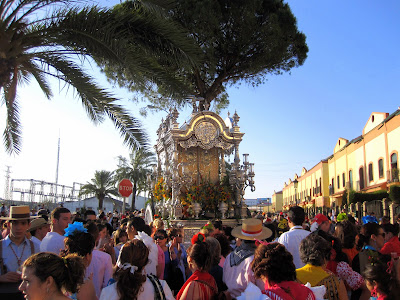
I have read, and throughout my traveling over the course of the year, confirmed that Andalucia is one of Europe's most strikingly colorful regions. It is known as the "mother" of the Spanish folklore: here you will live the magic of Gypsy Flamenco and bullfighting in their most authentic style, and myths like Don Juan and Carmen were born here. So, its tradition of bull fights, flamenco music and dance, and Moorish architecture, provides the strongest external image of Spain.

But I think that living in a small town in the heart of Andalucia has shown me how rich and colorful Spain is in its culture, its people and its traditions. The weekend of El Rocio has by far been the most cultural experience I have had this year. My town was buzzing with excitement over the anticipated weekend of El Rocio. Everyone was inviting me to walk or ride in their carriages. Students were asking me which day I was leaving and in which house I would be staying at. Teachers were offering me Flamenco dresses to wear and times to meet me. I was making plans and agreeing to things right and left. Finally I had to ask Guadalupe what exactly I was getting myself into...

The weekend of El Rocio dates back to the 13th century, when a hunter from a local village discovered a statue of the Virgin Mary in a tree trunk. A chapel was built where the tree stood and it became a place of pilgrimage. Devotion to this particular version of the Virgin was initially a local affair. Then, as the years passed brotherhoods were making the trip from nearby towns, they came from all over Huelva, Cadiz and Seville, on a journey taking up to four days. Over the next few centuries, the pilgrimage of the Virgin del Rocio became more and more widespread, and these days participants come from as far away as Barcelona and the Canary Islands - not to mention tourists who travel from abroad, around Europe and even further afield.

The El Rocio pilgrimage is the most famous in the region, attracting nearly a million people from across Andalucia and the entire country. Every Andalucian city, town and village has its own pilgrimages, for its patron saint, virgin or other much-loved local figure. But the El Rocio has the biggest status, and is the most important and most colourful.

Ok now picture this: Entire towns gathering together, to walk or ride in carriages and covered wagons, to a small town in the middle of nowhere, to pay their respect to a statue. Some towns come from so far away it takes days for them to arrive and they sleep in their wagons at night. What amazes me is that in the 21st century amongst our usual busy, hectic, technological lives there is still a tradition so special, so raw that it really puts things into perspective.

My little town of La Palma only had a day hike to El Rocio. They are located 15 miles from each other considering that no major highways are taken, only back roads. Since I was still recovering from my broken foot, I walked the first 3 miles to El Rocio and bailed in the next town over. There I was picked up by Guadalupe and we drove the rest of the way. We would stop at many little towns along the way and watch as La Palma passed through each town.

What made this experience so incredible was the atmosphere. Everyone was dressed up, everyone was singing rocieras (flamenco-style songs about the pilgrimage) as they travel and clapping to the songs. We would stop to take a break and dancing would ensue right in the middle of a pack of people, The energy was constant and the wine was constantly flowing. This whole procession is very religious but I also think its just another excuse for the Spanish to party!

When we arrived to the town I couldn't believe my eyes. There were thousands of people packed into such a small space. Everyone was singing and battling to get to the front in order to touch the statue. It was all a little much for me and I hung back with a group of teachers who were singing and dancing.

The town of El Rocío is a sprawling, pretty Wild-West-style place where you tie your horse to a wooden rail with a sign saying reserved for horses. There was sand everywhere, the roads unpaved because its easier on the horses hooves. What is normally a small, quiet, town in the middle of Huelva, for one weekend every year becomes Times Square on New Years Eve. Everyone wants to be there and part of the action.

Now most people stay in El Rocio for the entire weekend but I had to return home that night because bright and early the next morning, I was heading to Sevilla to meet my sister at the airport!


No comments:
Post a Comment